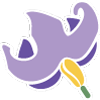n = ploidy missing =23 voucher missing = (Baylis 1954)
Along east coast of Australia, the mountainous spine of New Guinea and New Zealand, wet areas and disturbed sites; naturalized in South Australia (Symon, 1981).
Solanum aviculare is a member of the Archaeosolanum clade, a strongly supported monophyletic group in molecular analyses of using plastid DNA sequences, and is of no strong affinity with other groups of Solanum (Bohs, 1995). Symon (1981) places in series Avicularia Geras., with S. cheesmanii and S. baylisii, now both recognised as synonyms of S. aviculare. In Symon’s (1994) preliminary phylogeny based on morphology, Solanum aviculare is sister to the New Guinea endemic S. multivenosum, in a small monophyletic group with S. laciniatum.
Forster, J.G.A. 1786. Florae insularum australium prodromus.
J.C. Dietrich, Göttingen.
Forster, J.G.A. 1786. De plantis esculentis insularum oceani australis commentatio botanica.
Hande & Spener, Berlin.
Forster, J.G.A. 1786. Dissertatio inauguralis botanico-medica de plantis esculentis insularum oceani australis.
Typis Frankianus, Halle.
Merrill, E.D. 1954. Bibliographic notes on G. Forster’s “De plantis esculentis insularum oceani australis” (1786).
Pacific Sci. 8: 35-40.
Baylis, G.T.S. 1954. Chromosome number and distribution of Solanum aviculare Forst. and S. laciniatum Ait.
Trans. & Proc. Roy. Soc. New Zealand 82: 639-643.
Korneva, E.I., Z. Khabazi, Iu. S. Tursin & P.T. Kondratenko 1972. Intra specific variability of lobed nightshades and bird nightshades (in Russian).
Rastitel’n. Resursy 8: 507-515.
Stafleu, F.A. & R.S. Cowan 1976. Taxonomic literature. Vol 1: A-G.
Regnum Veg. 94.
Symon, D.E. 1981. A revision of Solanum in Australia.
J. Adelaide Bot. Gard. 4: 1-367.
Symon, D.E. 1994. Kangaroo apples: Solanum sect. Archaesolanum.
Published by the author, Keswick, South Australia.
Brickell, C.D., B.R. Baum, W.L.A. Hetterscheid, A.C. Leslie, J. McNeill, P. Trehane, F. Vrugtman & J.H. Wiersema 2004. International Code of Nomenclature for Cultivated Plants.
ISHS Acta Horticulturae 647.
Bohs, L. 2005. Major clades in Solanum based on ndhF sequences.
Pp. 27-49 in R. C. Keating, V. C. Hollowell, & T. B. Croat (eds.), A festschrift for William G. D’Arcy: the legacy of a taxonomist. Monographs in Systematic Botany from the Missouri Botanical Garden, Vol. 104. Missouri Botanical Garden Press, St. Louis.

Solanum aviculare is easily confused with S. laciniatum, herbarium specimens without fruit or annotations as to fruit colour can be difficult to identify. Baylis (1954) first identified the difference between these species. Solanum aviculare is diploid, with orange or red mature fruit, and about 600 seeds per fruit; S. laciniatum is tetraploid, with green mature frutis, and ca. 200 seeds per fruit. Both of these species have a long history of cultivation for horticulture and for alkaloids, with industry developed in the ex-Soviet Union, Australia and New Zealand (summarized in Symon, 1994). None of these industries have persisted, due perhaps to variability in supplies, alkaloid content or to lack of demand after the development of synthetic production.
Crosses have been made between S. aviculare and the diploid species S. linearifolium, S. vescum and S. simile and the tetraploid species S. laciniatum and S. symonii (summarized in Symon, 1994).
Solanum aviculare may be one of the diploid parents of the tetraploid species S. laciniatum (and perhaps also S. multivenosum) with S. vescum (Symon, 1994), but molecular methods testing these hypotheses have not been employed.
The publication of the name Solanum aviculare is complex. In 1786, Forster published three accounts of the plants he collected in Australia and the Pacific during Captain James Cook’s second voyage (HMS Resolution). The first, published in Halle between August and September, was his Dissertatio inauguralis (Forster, 19786), which appeared slightly earlier than the more commonly available trade version, De Plantis Esculentis (Forster, 1786b), published in Berlin and also printed between August and September 1786 (Stafleu & Cowan, 1976). The two versions differ only in title page and the deletion of a footnote on page 19 in the trade version (Merrill, 1954). The Flora insularum australium prodromus (Forster, 1786c), with much more abbreviated descriptions and often cited as the original place of publication of Solanum aviculare, was published in October in Gottingen (Merrill, 1954; Stafleu & Cowan, 1976). The name first appears with an excellent, clear description in the Dissertatio, making it the correct place of publication of the name Solanum aviculare, although many also cite De plantis esculentis; the description is identical, but the Dissertatio was published marginally earlier (Stafleu & Cowan, 1976).
The lectotype specimen labelled “Nova Zeelandia” was collected by Georg Forster in New Zealand during Captain Cook’s second voyage to the southern Hemisphere between 1772 and 1775. Many names treated as synonyms of Solanum aviculare (e.g. Solanum brisbanense (Gers.) Geras.) were never validly published as the descriptions lacked Latin diagnoses or type specimen citations. Korneva (Korneva et al. 1972) proposed many horticultural forms grown in the ex-USSR as varieties, but none of these names were accompanied with the citation of type specimens, making them not validly published under the ICBN (Article 37.1). These names have no nomenclatural standing, and even if they did, are perhaps more correctly treated under the International Code of Nomenclature for Cultivated Plants (Brickell et al., 2004).